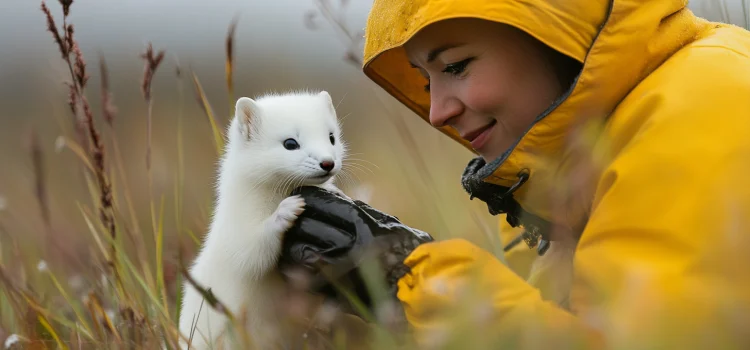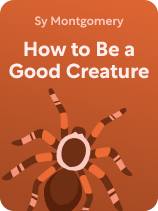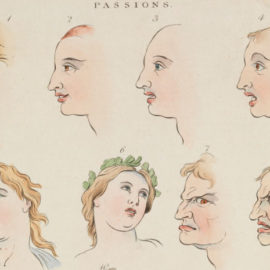

This article is an excerpt from the Shortform book guide to "How to Be a Good Creature" by Sy Montgomery. Shortform has the world's best summaries and analyses of books you should be reading.
Like this article? Sign up for a free trial here.
What can we learn from animals? What two animals changed Sy Montgomery’s perspective on living beings?
After deciding to become a nature writer, Sy Montgomery had many experiences with animals that helped her appreciate animals and people in new ways. We’ll look at the lessons she learned from two of those animals: a pinktoe tarantula and a chicken-stealing ermine.
Continue reading for the lessons animals can teach us.
Clarabelle the Tarantula
Montgomery’s experience with a pinktoe tarantula is one example of what we can learn from animals. The tarantula taught her how to appreciate the beauty and individuality of a species she previously feared. She describes how on a research trip to French Guiana, she was offered the chance to hold a tarantula that resided in the research team’s living quarters. Despite her fear of spiders, her curiosity drove her to accept.
(Shortform note: Like Montgomery, many people fear spiders—some estimates suggest that 6% of people have serious arachnophobia. However, only about 0.5% of spiders actually pose a danger to humans. Pinktoe tarantulas have a mild venom that won’t harm a human, and their other defense mechanism—fine hairs on their abdomen that they can use to sting predators—will typically only mildly irritate human skin.)
As Montgomery held the tarantula, she recognized the small animal’s individuality. Instead of viewing her as just a representative of a scary species, Montgomery began to feel an attachment to the tarantula—she felt a responsibility to care for and protect the little creature. She noticed her gentle, docile nature and her grace. As the trip went on, Montgomery’s affection for the spider—later named Clarabelle—increased, and her presence made Montgomery feel more at home.
(Shortform note: The respect, admiration, and care Montgomery felt as she held Clarabelle align with the ways animals are typically regarded in Buddhist traditions. In Buddhism, all animals (including often-maligned creatures like spiders) are considered sentient beings deserving of respect. Like humans, they’re believed to be capable of achieving enlightenment—a state in which a being is free from the cycle of life, suffering, and death. Thus, Buddhists try not to harm any living being, including spiders.)
Montgomery’s relationship with Clarabelle gave her a new appreciation for all spiders, opening her up to a whole different world that exists on a much smaller scale. When she returned to the US, she noticed and enjoyed the spiders around her home—creatures she never would’ve considered before.
(Shortform note: If you want to become a friend to spiders in your home like Montgomery, here are a few tips for engaging with them safely: First, it’s best not to touch spiders. Though most aren’t dangerous to humans, you could still get hurt or accidentally harm the spider if you pick one up. If you need to relocate a spider, you can move it using a cup or jar and a piece of paper. Finally, limit your use of pesticides as much as possible—they can introduce toxins to the environment that harm beneficial species.)
The Chicken-Stealing Ermine
Another animal who altered Montgomery’s perspective was an ermine—a member of the weasel family—who killed and stole one of her beloved chickens. One winter day, Montgomery found one of her chickens dead in their coop. When she tried to pick the chicken up, she came face-to-face with a snowy white ermine—the animal who had killed the hen.
(Shortform note: Ermines and other members of the weasel family are typically more helpful than harmful to human interests. They most often eat rodents such as mice, rabbits, and voles—animals that can become pests if unchecked. Typically, ermines only prey on chickens when other food sources are scarce, such as during winter, when the ermine killed Montgomery’s hen.)
The ermine stared back at Montgomery as if challenging her. She expected to feel anger toward the ermine because she loved the hen it killed. Instead, Montgomery found herself admiring it for its impressive feat and its fierce bravery in the face of a much larger creature like herself.
The ermine reminded Montgomery of her mother. Like the ermine, Montgomery’s mother had caused Montgomery a lot of hurt—she could be ill-tempered, controlling, and cruel as a parent. However, she was also a woman who escaped poverty, went to college, and built a career and a family at a time when societal norms made it difficult for a woman to do any of those things. Montgomery’s mother and the ermine were both individuals who succeeded against unlikely odds through their daring and determination.
After this experience, Montgomery’s perspective on her mother—who had died earlier that year—changed. She realized that she missed her mother deeply, despite their difficult relationship. Likewise, she found a new sense of admiration for all that her mother had accomplished.
| The Connection Between Forgiveness and Empathy By admiring the chicken-stealing ermine and thus learning to see her difficult mother in a new way, Montgomery demonstrated the connection between forgiveness and empathy. Some experts argue that to forgive someone, you must be able to empathize with them enough to understand the context surrounding their harmful actions. When you understand why they behaved as they did, you can offer them compassion and forgiveness, even though they hurt you. Montgomery was able to offer the ermine compassion because she understood that from the animal’s point of view, killing her chicken was a means to survive. Similarly, compassion allowed her to empathize with her mother—she understood her mother’s harmful behaviors in the context of a lifetime of hard work and struggle. However, some experts also note that extending forgiveness and compassion doesn’t mean excusing bad behavior or automatically welcoming the harmful person back into your life. It’s primarily a practice to allow you to heal and let go of some of your hurt. |

———End of Preview———
Like what you just read? Read the rest of the world's best book summary and analysis of Sy Montgomery's "How to Be a Good Creature" at Shortform.
Here's what you'll find in our full How to Be a Good Creature summary:
- Lessons about life and love that naturalist Sy Montgomery learned from animals
- How to appreciate animals and people in new ways
- How to be more curious, compassionate, friendly, and loving






